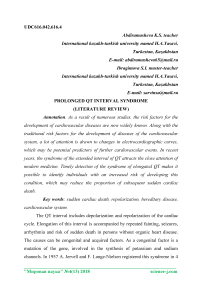Prolonged QT interval syndrome (literature review)
Автор: Abdiramasheva K.S., Ibragimova S.I.
Журнал: Мировая наука @science-j
Рубрика: Основной раздел
Статья в выпуске: 4 (13), 2018 года.
Бесплатный доступ
As a result of numerous studies, the risk factors for the development of cardiovascular diseases are now widely known. Along with the traditional risk factors for the development of diseases of the cardiovascular system, a lot of attention is drawn to changes in electrocardiographic curves, which may be potential predictors of further cardiovascular events. In recent years, the syndrome of the extended interval of QT attracts the close attention of modern medicine. Timely detection of the syndrome of elongated QT makes it possible to identify individuals with an increased risk of developing this condition, which may reduce the proportion of subsequent sudden cardiac death.
Sudden cardiac death, repolarization, hereditary disease, cardiovascular system
Короткий адрес: https://sciup.org/140263466
IDR: 140263466
Текст научной статьи Prolonged QT interval syndrome (literature review)
The QT interval includes depolarization and repolarization of the cardiac cycle. Elongation of this interval is accompanied by repeated fainting, seizures, arrhythmia and risk of sudden death in persons without organic heart disease. The causes can be congenital and acquired factors. As a congenital factor is a mutation of the gene, involved in the synthesis of potassium and sodium channels. In 1957 A. Jervell and F. Lange-Nielsen registered this syndrome in 4
related individuals with congenital deafness, and subsequently in persons without deafness. Acquired factors for the development of the extended QT interval are drugs such as antiarrhythmics, quinolone antibiotics, antidepressants, neuroleptics, methadone, etc. [1]. Congenital syndrome of prolonged QT interval is a hereditary disease characterized by a high risk of lifethreatening arrhythmias. The disease occurs in 1 out of 2,500 live births [2]. Congenital elongated QT syndrome (LQTS) is a hereditary impairment of myocardial repolarization, accompanied by an increased risk of potentially lifethreatening cardiac arrhythmias. At the molecular level, mutations in 15 different genes that code for the alpha subunits of the ion channel are involved in the pathogenesis of this syndrome.
Over the past two decades, the understanding of the pathogenesis and clinical management of congenital long QT syndrome, a potentially fatal heart repolarization disorder, has improved significantly. Clinically, LQTS is characterized by a tendency to fainting, cramping, and sudden cardiac arrest, often during emotional or physical overstrain. There are two different patterns of inheritance: autosomal dominant - Romano-Ward syndrome and autosomal recessive syndrome Gervell and Lange-Nielsen. The prevalence of the former varies between 1: 2000 and 1: 5000, and the second between 1: 1,000,000 and 1: 4,000,000, which is accompanied with bilateral sensorineal deafness. According to the US estimates, only a small number of annual sudden deaths in the United States are associated with LQTS and other syndromes of hereditary arrhythmia. The electrophysiology of the heart, such parameters as the QT interval, depends on the processes of depolarization and repolarization of the underlying action potential phases. Genetic defects in ion channels increase the depolarizing (input of Na + and Ca2 + currents) and reduce repolarization (potassium ions) by slowing the activation of potassium channels. This leads to an extension of the action potential, an increase in the period of refractoriness leads to an abnormal spontaneous activation of Ca2 + channels of the L type, which contributes to the occurrence of severe ventricular arrhythmias [3].
In the Department of Molecular Pharmacology and Experimental Therapy of Minnesota, patients with LQTS concomitant LVH were examined. Mortality during the follow-up period of ±217 from 184 days was 13% (23 of 181), in which LQTS was the main cause regardless of age and the presence of hypertension [4]. Risk factors for drug LQTS are hypokalemia, female sex, advanced age, genetic predisposition, hypomagnesemia, heart failure, bradycardia. Given these conditions, individuals with LQTS need regular monitoring of electrocardiography and electrolyte blood composition [5].
The toxicity of drugs with respect to the cardiovascular system is the main cause of drug withdrawal, development, clinical trial and distribution. The Food and Drug Administration (FDA) has rejected many pharmaceuticals due to the fact that they cause an elongated QT syndrome. But, despite this, these drugs can get approval from the FDA for clinical use. These compounds are saved only in favor of patients who need them. There are reports that, curcumin, possessing antitumoral ability can cause drug-induced QT syndrome [6]. And also, a number of medications, such as drugs used in Parkinsonism [7], psychotropic [8], antiarrhythmic IA and III class are potential drugs causing drug-induced LQTS [9].
Список литературы Prolonged QT interval syndrome (literature review)
- http://www.rmj.ru/articles_9770.htm
- Orphanet J Rare Dis. 2008. Congenital long QT syndrome. Crotti L1, Celano G, Dagradi F, Schwartz PJ.
- Curr Probl Cardiol. 2013. Genotype- and Phenotype-Guided Management of Congenital Long QT Syndrome. John R. Giudicessi, BA and Michael J.
- Heart Rhythm. 2014. Impact of left ventricular hypertrophy on QT prolongation and associated mortality.Haugaa KH, Bos JM, et al.
- Curr Med Res Opin. 2013. QT interval prolongation and the risk of torsades de pointes: essentials for clinicians. Trinkley KE1, Page RL.
- J Nanobiotechnology. 2013. Mitigating prolonged QT interval in cancer nanodrug development for accelerated clinical translation. Ranjan AP, Mukerjee A, Helson L.
- Parkinsonism Relat Disord. 2013 Nov. Outcomes of screening Parkinson's patients for QTc prolongation. Cunnington AL1, Hood K, White L.
- Can J Psychiatry. 2015. Impact of Age and Sex on QT Prolongation in Patients Receiving Psychotropics. Rabkin SW.
- Proc (Bayl Univ Med Cent). 2010. Causes and management of drug-induced long QT syndrome. Ayad RF1, Assar MD, Simpson L, Garner JB, Schussler JM.


